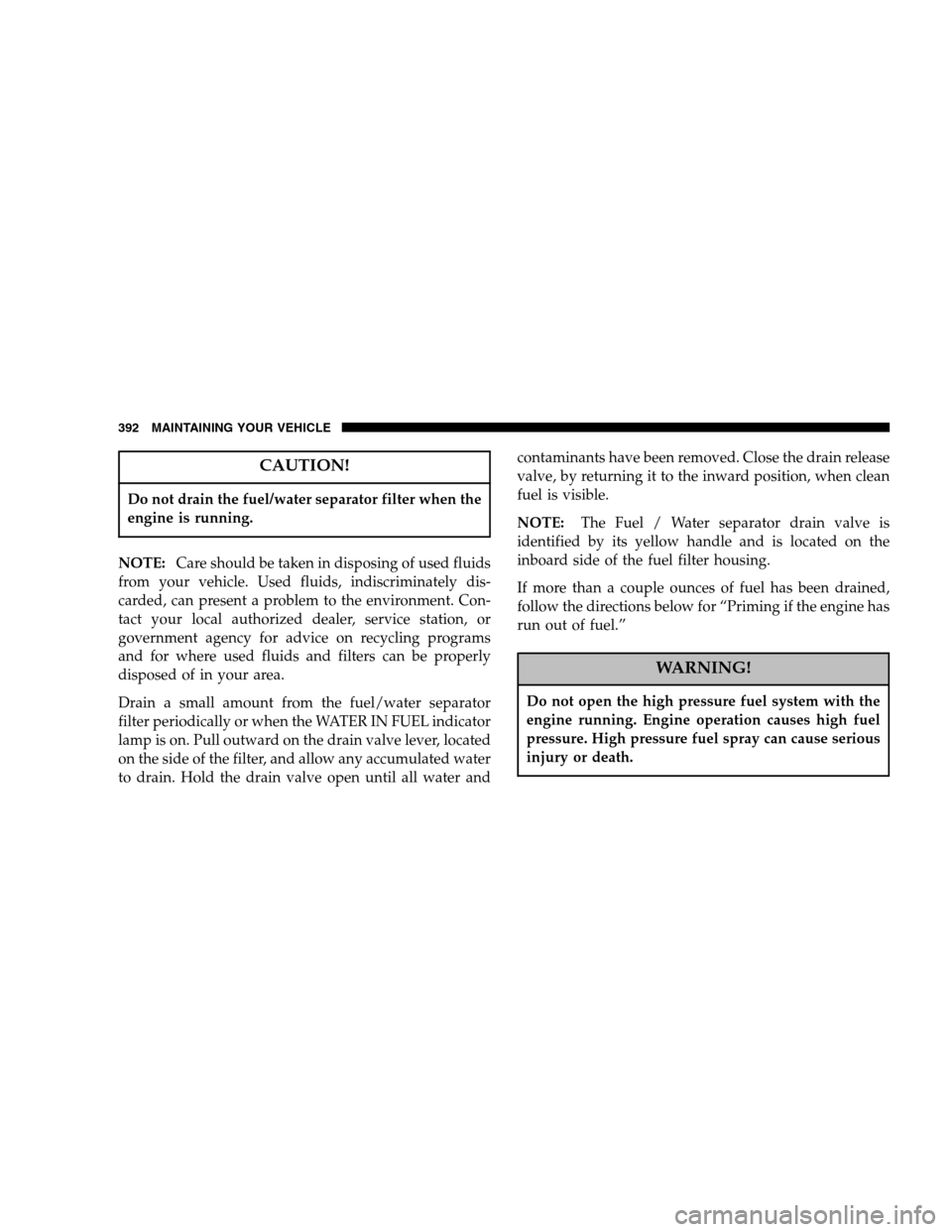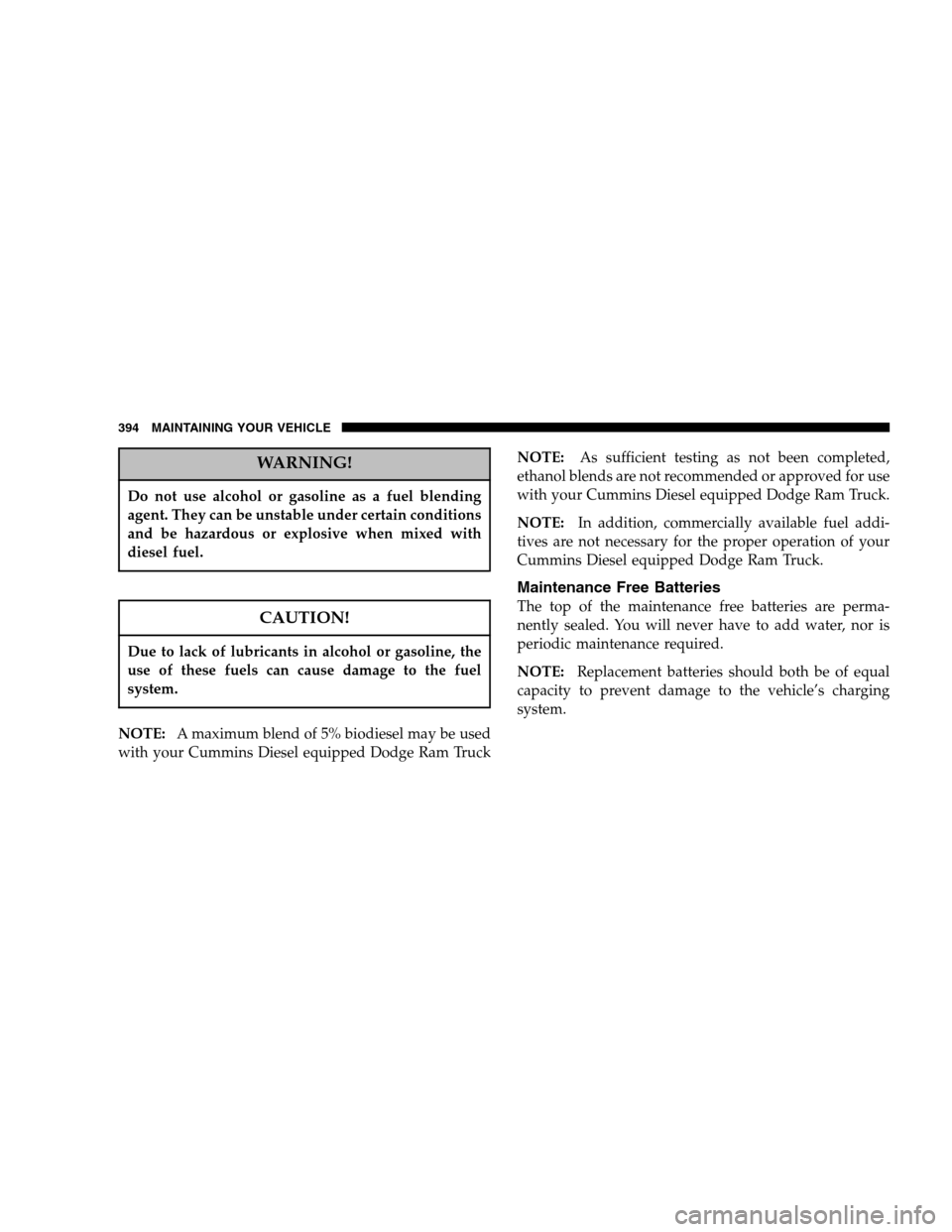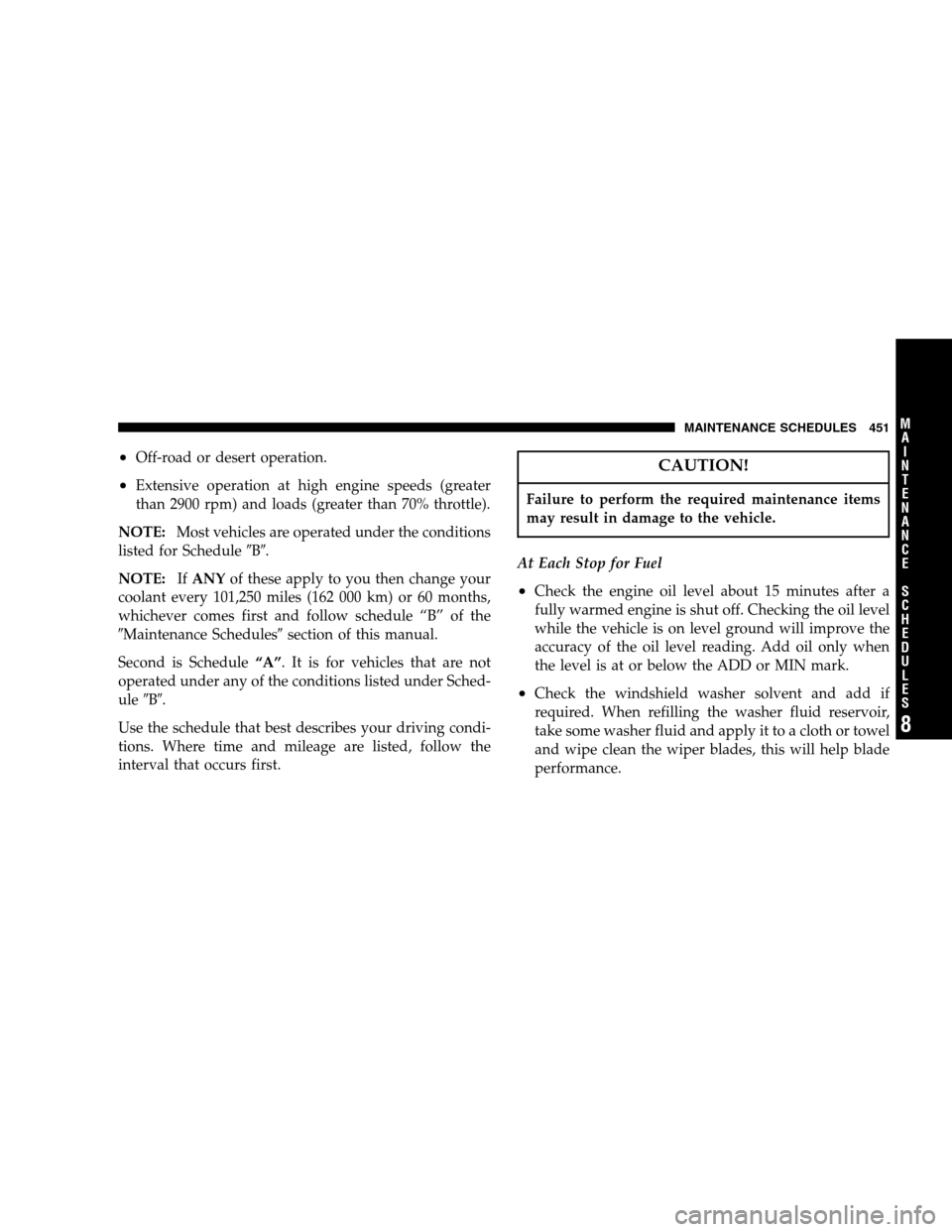Page 392 of 496

CAUTION!
Do not drain the fuel/water separator filter when the
engine is running.
NOTE: Care should be taken in disposing of used fluids
from your vehicle. Used fluids, indiscriminately dis-
carded, can present a problem to the environment. Con-
tact your local authorized dealer, service station, or
government agency for advice on recycling programs
and for where used fluids and filters can be properly
disposed of in your area.
Drain a small amount from the fuel/water separator
filter periodically or when the WATER IN FUEL indicator
lamp is on. Pull outward on the drain valve lever, located
on the side of the filter, and allow any accumulated water
to drain. Hold the drain valve open until all water and contaminants have been removed. Close the drain release
valve, by returning it to the inward position, when clean
fuel is visible.
NOTE:
The Fuel / Water separator drain valve is
identified by its yellow handle and is located on the
inboard side of the fuel filter housing.
If more than a couple ounces of fuel has been drained,
follow the directions below for “Priming if the engine has
run out of fuel.”
WARNING!
Do not open the high pressure fuel system with the
engine running. Engine operation causes high fuel
pressure. High pressure fuel spray can cause serious
injury or death.
392 MAINTAINING YOUR VEHICLE
Page 393 of 496
Priming if the engine has run out of fuel
1. Add a substantial quantity of fuel to the tank 5 to 10
gallons (19L to 38L).
2. Crank the engine for 1 to 2 seconds. If the engine does
not start, then release the key or starter button back to the
RUN position (do not turn the key back to the OFF
position). The electric fuel transfer pump will continue to
run and purge air from the system for about 25 seconds.
After 25 seconds, attempt to start the engine again.
3. Start the engine using the Normal Starting Procedure.
4. Repeat the procedure if the engine does not start.CAUTION!
Do not engage the starter motor for more than 15
seconds at a time. Allow two minutes between the
cranking intervals.
NOTE: The engine may run rough until the air is forced
from all the fuel lines.
CAUTION!
Diesel fuel will damage black top paving surfaces.
Drain the filter into an appropriate container.
MAINTAINING YOUR VEHICLE 393
7
Page 394 of 496

WARNING!
Do not use alcohol or gasoline as a fuel blending
agent. They can be unstable under certain conditions
and be hazardous or explosive when mixed with
diesel fuel.
CAUTION!
Due to lack of lubricants in alcohol or gasoline, the
use of these fuels can cause damage to the fuel
system.
NOTE: A maximum blend of 5% biodiesel may be used
with your Cummins Diesel equipped Dodge Ram Truck NOTE:
As sufficient testing as not been completed,
ethanol blends are not recommended or approved for use
with your Cummins Diesel equipped Dodge Ram Truck.
NOTE: In addition, commercially available fuel addi-
tives are not necessary for the proper operation of your
Cummins Diesel equipped Dodge Ram Truck.
Maintenance Free Batteries
The top of the maintenance free batteries are perma-
nently sealed. You will never have to add water, nor is
periodic maintenance required.
NOTE: Replacement batteries should both be of equal
capacity to prevent damage to the vehicle’s charging
system.
394 MAINTAINING YOUR VEHICLE
Page 408 of 496

Charge Air Cooler (Inter-Cooler)
The charge air cooler is positioned between the radiator
and the air conditioner condenser. Air enters the engine
through the air cleaner and passes through the turbo-
charger where it is pressurized. This pressurized air
rapidly reaches high temperature. The air is then directed
through a hose to the charge air cooler and through
another hose to the intake manifold of the engine. The air
entering the engine has been cooled by about 50 to 100
degrees Fahrenheit. This cooling process enables more
efficient burning of fuel resulting in fewer emissions.
To guarantee optimum performance of the system, keep
the surfaces of the charge air cooler, condenser and
radiator clean and free of debris. Periodically check the
hoses leading to and from the charge air cooler for cracks
or loose clamps resulting in loss of pressure and reduced
engine performance.
Hoses And Vacuum/Vapor Harnesses
Inspect surfaces of hoses and nylon tubing for evidence
of heat and mechanical damage. Hard or soft spots,
brittle rubber, cracking, tears, cuts, abrasions, and exces-
sive swelling indicate deterioration of the rubber.
Pay particular attention to those hoses nearest to high
heat sources such as the exhaust manifold. Inspect hose
routing to be sure hoses do not come in contact with any
heat source or moving component which may cause heat
damage or mechanical wear.
Insure nylon tubing in these areas has not melted or
collapsed.
Inspect all hose connections such as clamps and cou-
plings to make sure they are secure and no leaks are
present.
Components should be replaced immediately if there is
any evidence of wear or damage that could cause failure.
408 MAINTAINING YOUR VEHICLE
Page 445 of 496
3. Pull the bulb straight out from the socket.
4. Reverse procedure for installation of bulbs and hous-
ing.
Side Marker Lights (Dual Rear Wheels)
1. Push rearward on the side marker light assembly.
2. Pull the entire assembly from the fender. 3. Turn socket
1�4turn counterclockwise and remove from
assembly to access the bulb.
4. Pull bulb straight out from socket.
5.
Reverse procedure for installation of bulbs and housing.
FLUID CAPACITIES
FLUID CAPACITIES U.S. Metric
Fuel
2500 Shortbed Models 34 gal. 128L2500 Longbed Models 35 gal. 132L
3500 Shortbed Models 34 gal. 128L 3500 Longbed Models 35 gal. 132L
Engine Oil 5.9L Diesel Engine I-6 12.0 qts. 11.4L
Cooling System 5.9L Diesel Engine I-6 7 gal. 26.5L
MAINTAINING YOUR VEHICLE 445
7
Page 446 of 496
FLUIDS, LUBRICANTS AND GENUINE PARTS
Engine
Component Fluids, Lubricants and Genuine Parts
Engine Coolant Mopar �Antifreeze/Coolant 5 Year/100,000 Mile Formula HOAT (Hybrid Or-
ganic Additive Technology) or equivalent.
Engine Oil For the proper quality and SAE Grade oil for your engine, refer to the section � Maintenance Procedures.�
Engine Oil Filter Mopar �Engine Oil Filter, P/N 05083285AA or equivalent.
Engine Fuel Filter Mopar �Fuel Filter, P/N 05015581AB or equivalent.
Fuel Selection Use good quality diesel fuel from a reputable supplier. For most year-round service, No. 2 diesel fuel meeting ASTM specification D-975 will provide
good performance. This vehicle is fully compatible with biodiesel blends
up to 5% biodiesel meeting ASTM specification D-975. (See page 318 for
more information.)
446 MAINTAINING YOUR VEHICLE
Page 451 of 496

•Off-road or desert operation.
•Extensive operation at high engine speeds (greater
than 2900 rpm) and loads (greater than 70% throttle).
NOTE: Most vehicles are operated under the conditions
listed for Schedule �B�.
NOTE: IfANY of these apply to you then change your
coolant every 101,250 miles (162 000 km) or 60 months,
whichever comes first and follow schedule “B” of the
� Maintenance Schedules �section of this manual.
Second is Schedule “A”. It is for vehicles that are not
operated under any of the conditions listed under Sched-
ule �B�.
Use the schedule that best describes your driving condi-
tions. Where time and mileage are listed, follow the
interval that occurs first.
CAUTION!
Failure to perform the required maintenance items
may result in damage to the vehicle.
At Each Stop for Fuel
•Check the engine oil level about 15 minutes after a
fully warmed engine is shut off. Checking the oil level
while the vehicle is on level ground will improve the
accuracy of the oil level reading. Add oil only when
the level is at or below the ADD or MIN mark.
•Check the windshield washer solvent and add if
required. When refilling the washer fluid reservoir,
take some washer fluid and apply it to a cloth or towel
and wipe clean the wiper blades, this will help blade
performance.
MAINTENANCE SCHEDULES 451
8
M A I
N T
E
N A
N C E
S
C
H E
D
U L
E
S
Page 452 of 496
Once a Month
•Check tire pressure and look for unusual wear or
damage.
•Inspect the batteries and clean and tighten the termi-
nals as required.
•Check the fluid levels of coolant reservoir, brake
master cylinder, and transmission and transfer case (if
equipped), add as needed.
•Check Filter Minder™. Replace air cleaner filter
element if necessary.
•Check all lights and all other electrical items for correct
operation.
•Drain water from the fuel filter. At Each Oil Change
•Change the engine oil filter.
•Inspect the exhaust system.
•Inspect the brake hoses.
•Inspect the U-Joints ( if equipped) and front suspen-
sion components.
•Check the automatic transmission fluid level.
•Check the manual transmission fluid level.
•Check the coolant level, hoses, and clamps.
•Lubricate outer tie rod ends.
•Lubricate Front Drive Shaft Fittin
452 MAINTENANCE SCHEDULES
8
M
A I
N T
E
N A
N C E
S
C
H E
D
U L
E
S